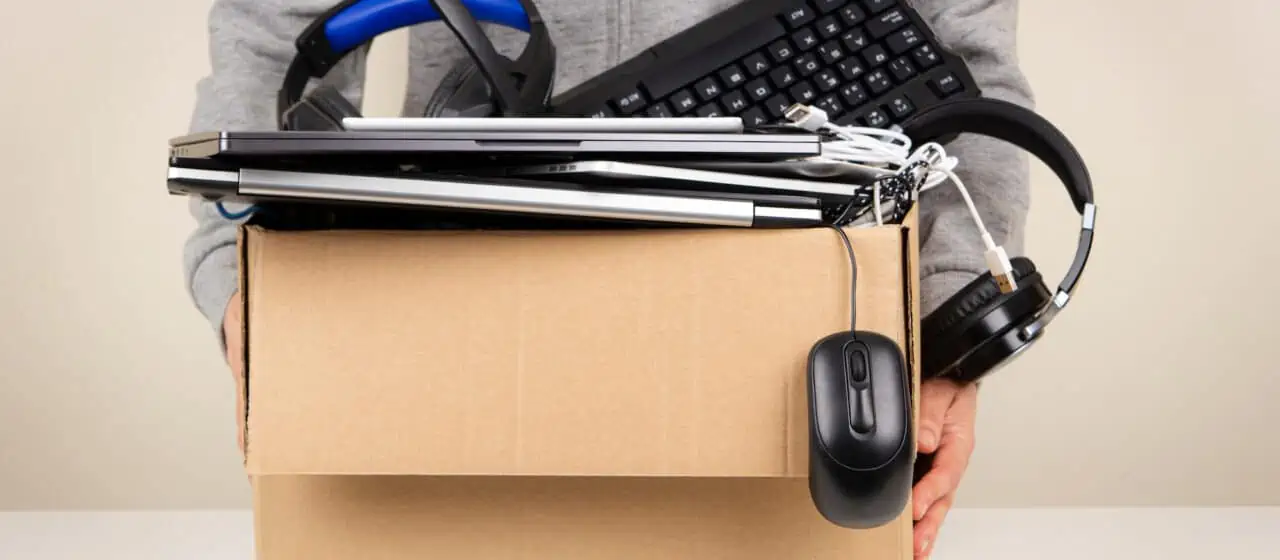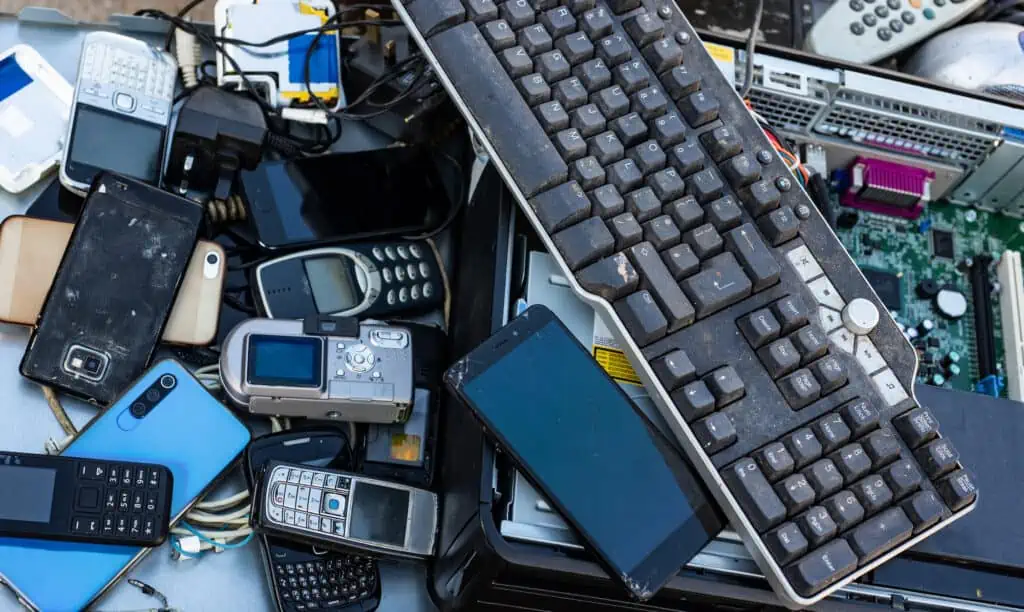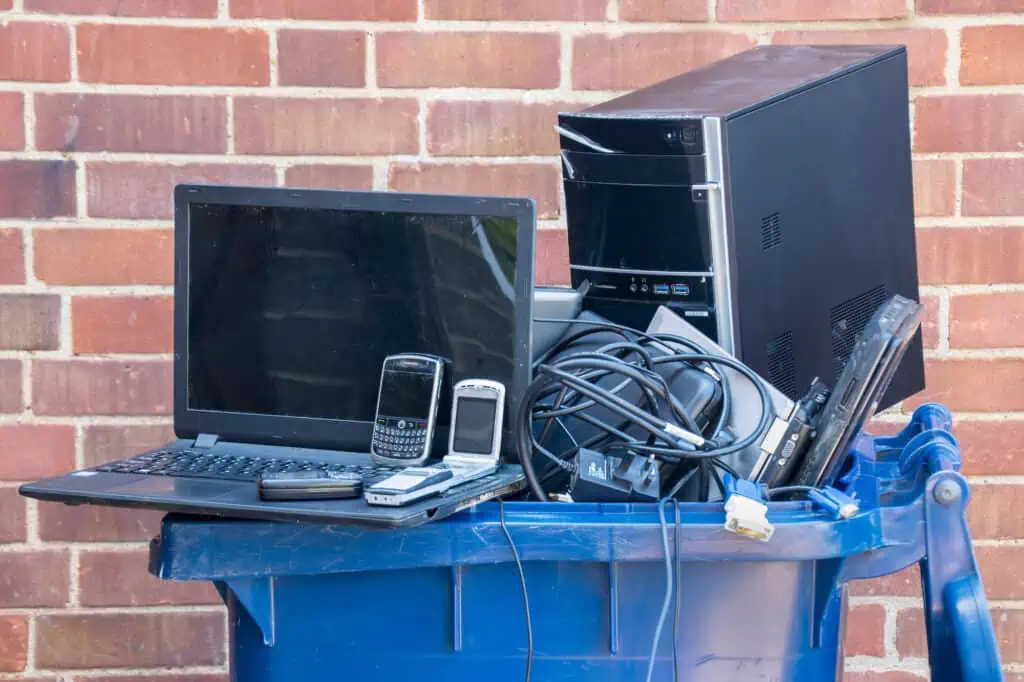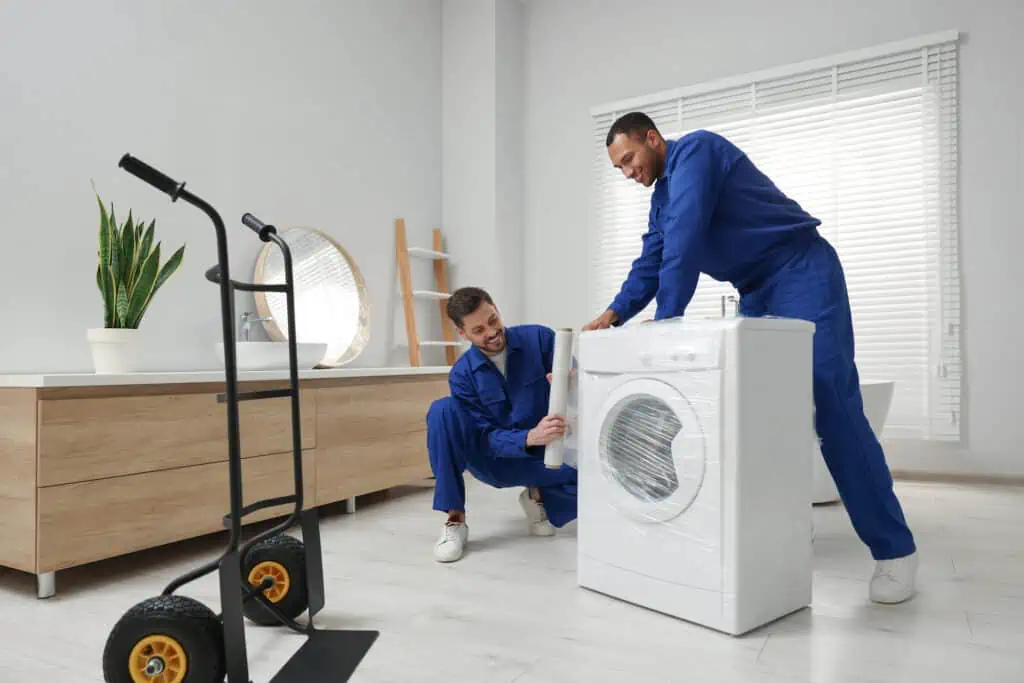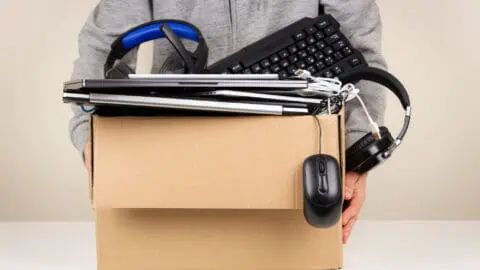How To Responsibly Ditch Electronic Waste When You Move
Posted in: I'm Moving, Green Moving, How To Pack, Moving AdviceMoving can be a great opportunity to declutter and get rid of stuff you no longer need. But there’s one category of junk that can’t simply go in the trash. E-waste is a term for electronics that no longer work, are close to the end of their usable life, or are simply unwanted. Think: computers, televisions, stereos, etc.
These types of waste present a danger if tossed in a dumpster or landfill, since they can emit toxins that leach into the soil, contaminate local water supplies, and if burned, contaminate the air.
Unfortunately, many people aren’t disposing of their e-waste properly. One research study by the University of California, Irvine found that greenhouse gas emissions from e-waste increased by 53% between 2014 and 2020.
So if you’re moving, it’s important to handle your e-waste responsibly. Here’s what you need to know.
What Is E-waste, Anyway?
E-waste refers to electronic waste, which is discarded electrical or electronic devices such as computers, smartphones, televisions, and household appliances. These products contain hazardous materials such as lead, mercury, and cadmium, which can have negative impacts on the environment and human health if not properly disposed of. In many cases, it’s actually illegal to put these items in the trash.
Some examples of e-waste include:
- Computers, laptops and tablets
- Televisions and monitors
- Mobile phones and chargers
- Printers and scanners
- DVD and Blu-ray players
- Game consoles
- Household appliances like refrigerators, washing machines, and dishwashers
- Medical equipment such as X-ray machines
- Compact fluorescent light bulbs (CFLs)
- Batteries and power banks
- Electronic toys
- Circuit boards and other internal components of electronic devices
How e-waste affects humans and our environment
E-waste not only contains many toxic substances, but the items themselves also involve manufacturing processes that are damaging to the environment and are made of components that don’t decompose. Some of the negative effects e-waste has on the environment include:
- Soil and water contamination: Improper disposal of e-waste can lead to the release of toxic substances into the environment, contaminating soil and water sources and affecting the health of plants, animals, and ecosystems.
- Depletion of natural resources: The production of electronics requires the extraction of finite natural resources, such as minerals, leading to resource depletion and environmental degradation.
- Climate change: The production and disposal of e-waste also contribute to greenhouse gas emissions, contributing to climate change. One study found that for every ton of CRT display products manufactured, 2.9 metric tons of carbon were released. However, when properly recycled, only 10% of greenhouse gas emissions are released.
See prices for local moving labor. Read real customer reviews. Easily book your help online.
E-waste also has adverse health effects for people since it contains hazardous substances such as lead, mercury, cadmium, brominated flame retardants, and polycyclic aromatic hydrocarbons (PAHs). Some of the health problems that result from e-waste exposure include:
- Respiratory problems, like bronchitis, lung cancer, and other lung-related illnesses
- Reproductive problems, like birth defects, infertility, and developmental problems in children
- Nervous system damage, like tremors, memory loss, and hearing loss
- Skin irritation and rashes
Top 5 worst electronics to throw in the trash
Though e-waste comes in many forms, there are a few common items you should particularly watch out for when getting rid of unwanted stuff.
- Old TVs: Televisions can contain large amounts of toxic material. For instance, the glass in a square-box CRT television contains up to eight pounds of lead! And if the glass breaks, these chemicals are released into the air and ground.
- Computers: There are many components within a computer that are toxic, including mercury and lead. But there are also some valuable materials, such as copper, aluminum, and gold. In fact, old computers can be used to manufacture refurbished ones, and there are many programs that help computer owners recycle their old units.
- Cell phones: Manufacturing cell phones creates a lot of greenhouse gas emissions. And like computers, cell phones contain many valuable materials like glass and precious metals. So it’s important that they’re recycled. In fact, by recycling one million cell phones, you can save enough electricity to power 185 U.S. households for a year.
- Printers: Many toxic chemicals are present in printing ink and toner cartridges alone. Not to mention, printers also have plastic housing, printed circuits, and other components that are bad for the environment.
- CDs and DVDs: These discs and their cases take up space in landfills and essentially never break down. It’s estimated that CDs and DVDs take one million years to completely decompose in a landfill.
How To Reduce E-waste When You Move
When you start cleaning and packing up for a move, you might find old, broken electronics in your attic or garage. Or you might decide that you want to upgrade your TV and appliances in your new home, and ditch your outdated stuff. And hopefully, there aren’t any electronics that get irreparably damaged during your move, but it does happen (which is why you might want to look into moving insurance).
“If possible [when packing], use the original packaging for your electronics, since it’s designed specifically for the device and can provide the best protection during transport.”
Whatever the case, you don’t want to be part of the e-waste problem, as it negatively impacts the environment and poses a threat to human health. But what, exactly, are you supposed to do with it? Here are a few options.
Care for electronics properly to extend their lifespan
As they say, an ounce of prevention is worth a pound of cure, and one way to reduce e-waste is to avoid creating it in the first place. There are a few things you can do to extend the life of your electronics:
- Clean and maintain: Dust, dirt, and grime can cause damage to electronic components, so it’s important to clean your devices regularly. Follow manufacturer recommendations for cleaning and maintenance to keep your electronics in good working order.
- Use proper storage: Store electronics in a dry and cool place to prevent damage from moisture, heat, and sunlight. Avoid exposing them to extreme temperatures or humidity levels.
- Use protective cases: This is especially important for portable devices such as smartphones and tablets, to prevent scratches and damage from drops.
- Avoid overcharging: Overcharging can reduce the lifespan of batteries. Follow manufacturer recommendations for charging and avoid leaving your devices plugged in overnight.
- Update software: Software updates often contain bug fixes and security patches that can prolong the lifespan of your device.
- Repair instead of replace: Many issues can be fixed with a simple repair, and this can save you money and reduce electronic waste.
Pack properly to avoid damage
Moving electronics can be challenging, but with proper packing, you can ensure that they arrive at your new home in good condition.
Before packing, disassemble any detachable parts such as cables, cords, and batteries, and wrap each part separately. If possible, use the original packaging for your electronics, since it’s designed specifically for the device and can provide the best protection during transport. Otherwise, wrap your electronics with bubble wrap or packing paper, securing the wrap in place with packing tape. Ensure that all parts are fully covered. During transport, keep the boxes upright and secure them in your vehicle to prevent shifting or damage.
See prices for local moving labor. Read real customer reviews. Easily book your help online.
Donate
If you have electronics that you no longer want but are still in good working condition, consider donating them to a local school, charity, library, or community organization. There are likely many local charities near you, and some might specifically be looking for electronic donations. It’s always best to call the center or charity beforehand to make sure they’re able to take your particular electronics.
Before donating, be sure to erase any personal data from the device. Also try to include any necessary accessories such as power cords, charging cables, and remote controls. And don’t forget to request a receipt for your donation for tax purposes.
Sell
If your electronics are still in demand and have value, consider selling them. It might require a bit more time and effort, but it’s a great way to make some extra money while also decluttering your home.
To prep your items for sale, start by researching their value by checking online. Then make sure to clean your electronics and test them to ensure that they are working properly. Also, take clear and well-lit photos to show the condition and any accessories included.
“One research study by the University of California, Irvine found that greenhouse gas emissions from e-waste increased by 53% between 2014 and 2020”
Once you have good photos and idea of a price point, then you can create a listing on the platform of your choice, such as eBay, Amazon, Facebook Marketplace, Craigslist, or other online marketplaces. Each platform has its own selling fees, policies, and buyer audience, so do some research and choose the best fit for you.
Repair and reuse or gift
If your electronic item is in need of repair, consider fixing it instead of replacing it with a new device. Even if you don’t plan to keep it, a refurbished phone or tablet could make a great gift option and help you avoid having to go out and buy something brand new.
Of course, you should evaluate the cost of repair and compare it to the cost of a new device. If the repair cost is more than half the cost of a new device, it may not be worth fixing.
Recycle
Recycling e-waste is one of the best things you can do, as it contributes to the “circular economy.” Recycling conserves natural resources by reducing the need for virgin materials in the production of new electronics. It also uses less energy, reducing greenhouse gas emissions and contributing to efforts to mitigate climate change. Not to mention, recycling e-waste keeps it out of landfills.
E-waste can be recycled at various locations, including:
- E-waste recycling centers: Many communities have dedicated e-waste recycling facilities where you can drop off your electronic waste for proper disposal and recycling.
- Retail electronics stores: Some retailers, such as Best Buy, offer e-waste recycling services, allowing you to recycle your old electronics when purchasing new ones.
- Manufacturer take-back programs: Some electronics manufacturers, including Apple, Dell, and Sony, have established take-back programs where they will accept and recycle their own brand of e-waste.
- Electronic waste collection events: Many communities organize periodic e-waste collection events where residents can bring their old electronic items for recycling. Look out for upcoming events on community Facebook pages, the Nextdoor app, and the local paper.
- Specialty e-waste recyclers: There are also specialized e-waste recycling companies that focus on the safe and proper disposal of electronic waste.
Keep in mind that it’s important to research and find a reputable e-waste recycling facility or program, as not all facilities use environmentally responsible practices.

